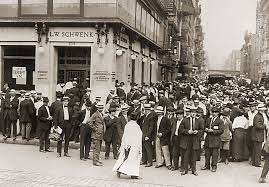On September 21, 1931, the United States was grappling with significant problems within its banking system. The country was in the midst of the Great Depression, a severe economic downturn that had started in 1929 and caused widespread unemployment, poverty, and financial instability. The banking system in the United States had been severely weakened by the economic crisis. The stock market crash of 1929 had led to a collapse in asset values, leaving many banks with significant losses. Additionally, the economic downturn had resulted in a decline in business activity and a sharp increase in loan defaults, further straining the financial health of banks. One of the main issues faced by the banking system was a wave of bank failures. As the economy worsened, depositors began to lose confidence in the stability of banks and rushed to withdraw their funds. This sudden increase in withdrawals put immense pressure on banks, many of which were already struggling to maintain sufficient reserves to meet customer demands. The banking panic was fueled by a lack of trust and fear of losing savings. Depositors, worried about the solvency of their banks, sought to withdraw their money all at once, leading to a vicious cycle of bank runs. These bank runs only exacerbated the financial crisis, as banks were unable to meet the overwhelming demand for withdrawals, causing even more banks to fail. The failure of banks had severe consequences for both individuals and the broader economy. Many people lost their life savings, leaving them financially devastated. Businesses also suffered as the lack of access to credit and capital hindered their ability to operate and expand. The resulting economic contraction deepened the already dire conditions of the Great Depression. Recognizing the urgent need to stabilize the banking system, President Herbert Hoover and his administration took steps to address the crisis. One of the key measures implemented was the creation of the Reconstruction Finance Corporation (RFC) in 1932. The RFC provided financial assistance to struggling banks, aiming to restore confidence and prevent further bank failures. However, these efforts were not enough to fully resolve the banking crisis. It was not until the subsequent administration of President Franklin D. Roosevelt that more comprehensive measures were taken. Under Roosevelt's leadership, the Emergency Banking Act was passed in 1933. This legislation aimed to restore public confidence in the banking system by declaring a bank holiday, temporarily closing all banks to assess their solvency and implement reforms. The Emergency Banking Act was followed by the establishment of the Federal Deposit Insurance Corporation (FDIC) in 1933. The FDIC provided deposit insurance, guaranteeing the safety of bank deposits up to a certain amount. This measure not only restored confidence in the banking system but also provided a safety net for depositors, ensuring their funds would be protected even if a bank failed. The problems within the US banking system on September 21, 1931, were indicative of the broader economic turmoil of the Great Depression. The crisis highlighted the vulnerabilities and weaknesses of the financial sector, prompting significant reforms and the establishment of institutions that continue to play crucial roles in maintaining the stability of the US banking system to this day.
21 Sept, 1931 US Banking System Problems
